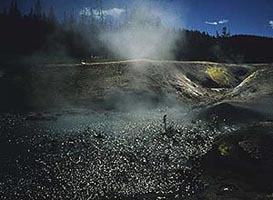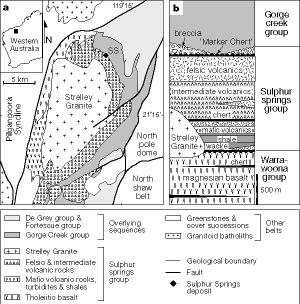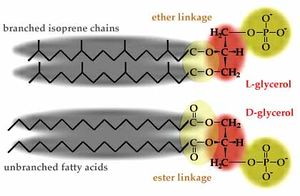Evolution of Thermophilic Archaea: Difference between revisions
| Line 9: | Line 9: | ||
==Possible Microfossils at Kangaroo Caves== | ==Possible Microfossils at Kangaroo Caves== | ||
In 2000, strange filaments were first reported in volcanic hosted massive sulfide deposits (VHMS) at the Kangaroo Caves Formation, East Pilbara, Western Australia. It was hypothesized that these filaments were microfossils, specifically of ancient thermophilic chemotrophs. Though non-biological filamentous mineral growths can be easily found in sulfide deposits, the filaments at Kangaroo Caves differed in that they were unbranched, with constant diameters. Moreover, they were entangled and clustered in specific ways which resemble those of certain modern thermophilic microbes and other microfossils. | In 2000, strange filaments were first reported in volcanic hosted massive sulfide deposits (VHMS) at the Kangaroo Caves Formation, East Pilbara, Western Australia. It was hypothesized that these filaments were microfossils, specifically of ancient thermophilic chemotrophs. Though non-biological filamentous mineral growths can be easily found in sulfide deposits, the filaments at Kangaroo Caves differed in that they were unbranched, with constant diameters. Moreover, they were entangled and clustered in specific ways which resemble those of certain modern thermophilic microbes and other microfossils. | ||
[[Image:405676aa 2.jpg|thumb|right|Figure showing the geology and location of the possible microfossils at Kangaroo Caves]] | [[Image:405676aa 2.jpg|thumb|right|Figure showing the geology and location of the possible microfossils at Kangaroo Caves]] | ||
Changes in orientation of filaments in different areas may even evidence of biological variation between organisms in differennt microenvironments; such a phenomenon is common today in modern hot-spring thermophiles. | |||
<br>Metal precipitation and volcanic rock textures indicate that East Pilbara was once covered by over 1000 m of seawater. It is estimated from looking at the minerals in the ore that temperature might have reached 300 degrees Celsius, and this hypothesis, coupled with the volcanic rock found in the deposit, is substantial evidence that Kangaroo Caves was once a hydrothermal vent in a primordial sea. | <br>Metal precipitation and volcanic rock textures indicate that East Pilbara was once covered by over 1000 m of seawater. It is estimated from looking at the minerals in the ore that temperature might have reached 300 degrees Celsius, and this hypothesis, coupled with the volcanic rock found in the deposit, is substantial evidence that Kangaroo Caves was once a hydrothermal vent in a primordial sea. | ||
Revision as of 01:48, 16 April 2009
Crenarcheota and Hyperthermophiles: An Overview
Thermophilic and hyperthermophilic archaea, specifically crenarcheotes in the class Thermoprotei, are known to inhabit environments such as hot springs, ocean vents, and geysers which are inhospitable to many other forms of life.
Such habitats are high in concentrations of reduced minerals and temperature, and low in concentration of oxygen and often in pH. Though various genera of these archaea flourish at different temperatures, the most striking examples of hyperthermophiles include archaea in the genera Pyrodictium, which are adapted to live around thermal vents at the ocean floor, at temperatures ranging from 100-110 degrees Celsius. Acidophiles are also prevalent in this class, especially those belonging to the order Sulfolobales: Sulfolobus solfatericus flourishes at a pH ranging from only 2 to 4.
Though certain species of Thermoprotei use oxygen in respiration, most of the metabolisms of these archaea are anaerobic. Ignicoccus islandicus oxidizes hydrogen with sulfur, forming hydrogen sulfide. Pyrodictium might oxidize hydrogen with sulfur or else use anaerobic fermentation.
The hostile habitats in which crenarcheotes live resemble, in many cases, the conditions on early Earth. As the early atmosphere is believed to have had no oxygen in it, the first life forms to develop must clearly have been anaerobic. If life forms evolved before Earth cooled--and it is quite possible that they did, as they could have flourished beneath Earth's forming crust, away from crashing meteorites--these organisms might have been the ancestors of today's thermophilic prokaryotes, including archaea.
Possible Microfossils at Kangaroo Caves
In 2000, strange filaments were first reported in volcanic hosted massive sulfide deposits (VHMS) at the Kangaroo Caves Formation, East Pilbara, Western Australia. It was hypothesized that these filaments were microfossils, specifically of ancient thermophilic chemotrophs. Though non-biological filamentous mineral growths can be easily found in sulfide deposits, the filaments at Kangaroo Caves differed in that they were unbranched, with constant diameters. Moreover, they were entangled and clustered in specific ways which resemble those of certain modern thermophilic microbes and other microfossils.
Changes in orientation of filaments in different areas may even evidence of biological variation between organisms in differennt microenvironments; such a phenomenon is common today in modern hot-spring thermophiles.
Metal precipitation and volcanic rock textures indicate that East Pilbara was once covered by over 1000 m of seawater. It is estimated from looking at the minerals in the ore that temperature might have reached 300 degrees Celsius, and this hypothesis, coupled with the volcanic rock found in the deposit, is substantial evidence that Kangaroo Caves was once a hydrothermal vent in a primordial sea.
The rocks and the structures in them are about 3.2 billion years old, meaning that if these filaments really are the remains of primitive microbes, they were flourishing in the Archaean Eon, at the same time as many ancient cyanobacteria. Neither cell structure nor metabolism can be determined by looking at these filaments; even if we could be sure that they were microfossils, we could still not tell whether they were bacteria or archaea. However, it is exciting evidence that thermophilic life did exist on early Earth and perhaps evolved even earlier. It is possible that these thermophiles are the ancestors of modern thermophilic archaea.
A Possible Thermophilic Ancestor of Archaea
Three main features present in most species of archaea might have been adaptations to high temperatures, perhaps indicating that the common ancestor of all archaea was a hyperthermophile. The first characteristic is the ubiquitous presence of the enzyme reverse gyrase. As its name suggests, reverse gyrase coils DNA in the opposite direction in which regular gyrase coils it: DNA coiled by reverse gyrase form positive supercoils instead of negative supercoils. Most thermophiles, both bacteria and archaea, have positive supercoils in their DNA; as positive supercoils are stronger and more difficult to untangle than negative supercoils, they are useful to organisms which grow at high temperatures. The heat cannot destroy the genetic material as easily. While not all the DNA in today's archaea is found in positive supercoils, reverse gyrase is found not only in thermophilic archaea, but in some species of mesophilic archaea, indicating that perhaps it was present in the common ancestor of all archaea.
The second characteristic is the ether-linked lipids found in archaeal membranes. Because ether bonds are much stronger than ester bonds, the membrane lipids of archaea do not easily come apart at high temperatures, unlike the ester-linked lipids of most bacteria. Ester-linked lipids are the only kind of glycolipids present in archaea; here is further evidence of thermophilic ancestors passing on heat adaptations to future generations. The third characteristic is the high number of modified nucleosides in archaea. Most of the modification occurs in the bases of these molecules. Nine modified nucleosides are known to be present only in archaea, and all of them are most commonly found in thermophilic species, most of which were discovered in a 1991 experiment in the Department of Medicinal Chemistry at the University of Utah. Eleven species of thermophilic archaea were studied in this experiment: Thermoplasma acidophilum, Methanobacterium thermoautotrophicum, Archaeoglobus fulgidus, Methanothermus fervidus, Sulfolobus solfataricus, Thermoproteas neutrophilus, Acidianus infernus, Thermodiscus maritimus, Thermococcus sp., Pyrobaculum islandicum, and Pyrodictium occultum. The occurrance of the same modified nucleosides across these different genera of thermophiles indicates at least a common ancestor of thermophilic archaea, if not of archaea in general.
Section 3
Include some current research in each topic, with at least one figure showing data.
Conclusion
Overall paper length should be 3,000 words, with at least 3 figures.
References
Edited by student of Joan Slonczewski for BIOL 238 Microbiology, 2009, Kenyon College.




